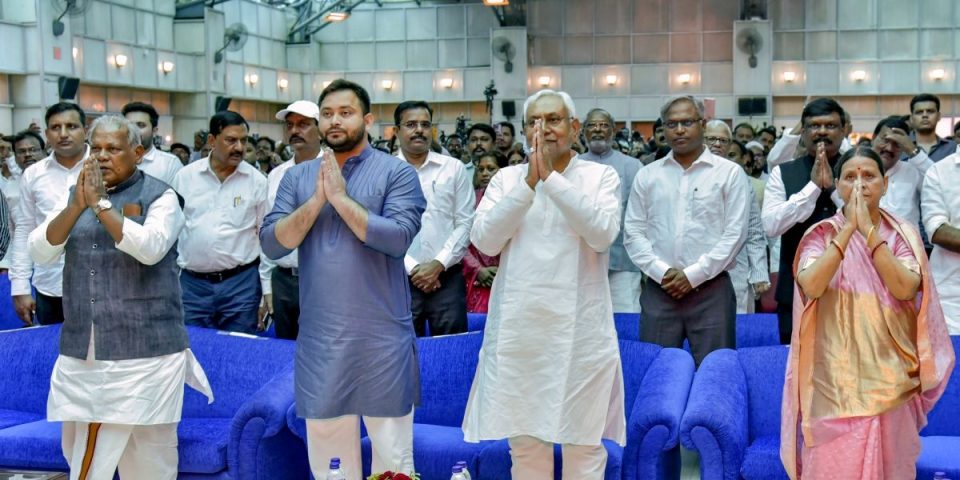
With unique caste dynamics in Bihar, it may be Dilli Chalo for Nitish
The formidable emergence of the Yadavs, Kurmis and Koeris is being viewed as a revolutionary change; another game-changer in the state can be Nitish Kumar's move to national politics

In an informal get-together in a politically conscious UP town, some elderly followers of Jayaprakash Narayan were rejoicing at the prospect of two dynamic student leaders from the JP Movement of the 1970s coming together in neighbouring Bihar after five decades. The coming together of long-time rivals Lalu Prasad and Nitish Kumar to make common cause in politics was interpreted by them as the beginning of a new “total revolution”.
The hype in the description aside, the transition from upper caste consolidation under the BJP, incorporating a section of OBCs, viz, Kurmis, to an OBC consolidation carrying along a small section of upper castes like Bhumihars, is a topsy-turvy change, no doubt. In Bihar itself, this change has been generally welcomed by all in the Opposition circles.
Electoral caste arithmetic
No matter how total and comprehensive this ‘total revolution’ is, what is unique about it is it is a silent revolution. Mandal is a taboo word now. There is no talk of ‘social justice’ or OBC unity in a conscious bid to avoid polarisation. De-polarisation is the name of the game now. The reason lies in the compulsions of the electoral caste arithmetic.
Triveni Sangh – the unity of Yadavs (an estimated 14.4 per cent of the Bihar population), Kurmis (4 per cent) and Koeris (8 per cent) – as a proposition was raised by some intellectuals in Bihar in the early 1990s in the wake of the original Mandal wave. This has been realised now and constitutes the core of the new alignment in Bihar, into which they have also rallied Muslims (around 17 per cent).
Also read: Nitish Kumar ‘strong’ PM candidate for 2024, says Tejashwi Yadav
Socially and electorally this can prove to be a formidable consolidation provided the Most Backward Castes (MBCs, which comprise assorted castes like Nishads, Telis, and a section of the backward caste Banias etc., constitute around 18 per cent of the population) and a section of Dalits (15 per cent of the Bihar population) cast their lot with them along with a section of the upper castes.
Triveni Sangh
Triveni Sangh may already be a reality but strangely nobody talks about it now, so as not to scare away a section of the upper castes, which may prefer to stay with Nitish, who is playing his caste cards carefully.
For example, though he has not included the Bhumihar stalwart Lallan Singh in his ministry, the latter has been retained as the JD(U) president. Likewise, in the face of sharp public criticism against the inclusion of another Bhumihar strongman Kartik Kumar from the RJD in the ministry as law minister, in view of the kidnapping and other criminal cases pending against him, and when even Mahagathbandhan allies like Congress and CPI(ML) (L) demanded that he be dropped from the ministry, Nitish performed a subtle balancing act by only shifting him to the sugarcane industry ministry. But, in defiance, Kartik Kumar resigned from the ministry. Whether it marks the beginning of a Bhumihar backlash and alienation from the Nitish government remains to be seen.
Fluid situation
This episode as well as the ground reports indicate that the situation is still fluid and social realignment as a consequence of the political realignment is yet to culminate. It may get disturbed slightly, depending upon who takes the greater blame in the coming days in Bihar for issues like price rise, unemployment, crime, and extortion – Nitish or Modi.
Also read: Nitish’s socio-economic plank could decimate BJP’s Hindutva pitch

There is another factor that can be a game-changer. There is speculation about a deal between JD(U) and RJD that Nitish will be projected as the Opposition candidate for Prime Minister in 2024 and he will move to all-India politics, leaving the Bihar throne to Tejashwi. But that depends on the acceptability of Nitish’s leadership by the assorted forces in the Opposition camp.
Nitish’s profile outside Bihar is not strong as yet and he will face powerful contenders in Rahul Gandhi and Mamata, to mention just two. But, objectively, he remains in the race as with the backing of the RJD he has clout over a majority of the 40 Lok Sabha seats in Bihar. Moreover, there is no corruption case against him. At present, he has broad support in Bihar and not just from one set of castes. Though a majority of the upper castes are still with the BJP, there is no sharp anger or hostility against Nitish among them.
Pan-India space
The space for Nitish expanded in all-India Opposition politics after Modi effectively bottled up Mamata within West Bengal, with a series of CBI-ED raids on several of her lieutenants in the TMC. Mamata too made a compromise overture to Modi through her boycott of the vice-president polls. Akhilesh too is not taking an active role in forging Opposition unity as he faces some disarray in his own ranks in UP, after the debacle in the by-polls and divisions within his own family.
K Chandrashekar Rao (KCR), however, has taken the lead and travelled to Patna to meet both Nitish and Tejashwi. Though he has flagged off the Nitish-centric manoeuvres for Opposition unity, simultaneously, he has also started a divisive move within the Opposition by calling for unity of non-Congress – though not anti-Congress – Opposition forces.
Also read: BJP should worry about 2024 polls, says Nitish after taking over as CM
Strangely, neither Mamata nor Akhilesh nor MK Stalin nor Sharad Pawar nor Uddhav Thackeray has welcomed the Nitish-KCR statements on Opposition unity against Modi from Patna. Reports from the media grapevine, however, indicate that Nitish is planning an all-India tour to meet all Opposition leaders and other non-BJP regional forces and explore the prospects of a joint front against the BJP government at the Centre. Nitish’s all-India role may then gather steam.
BJP strikes back
Anticipating a direct challenge to Modi by Nitish in 2024, the BJP has already started its offensive against this coalition from day one. Amit Shah called the gathbandhan a “thug-bandhan” and declared that Jungle Raj 3.0 had begun. He also announced his visit to Kishanganj and Purnea in Muslim-concentrated east Bihar. This visit is ostensibly to woo Pasmanda Muslims, as Bihar has 1.5 crore Pasmanda Muslims who are identified as “Dalit or very backward Muslims” and Bihar is the birthplace of their organisation Pasmanda Muslim Mahaz.
The Nitish administration, however, is nervous and officials are anticipating some communal flare-ups. There are also signs of the long dormant RSS riot machinery getting activated now.
Pranav-Kumar Chaudhary, a senior journalist, had earlier told The Federal: “When Tejashwi declared that the new government would create 10 lakh government jobs, Nitish not only endorsed it but clarified that 10 lakh government jobs would be created and another 10 lakh private sector jobs would be generated (dus lakh naukri, dus lakh rozgar). This has created a lot of enthusiasm among youth cutting across caste lines.
Wooing women voters
“Nitish Kumar has also carefully cultivated an electoral appeal among women by recruiting more women in the police force, banning liquor, promoting girls’ education, and bringing down crimes against women. So he enjoys the support of women from all castes. And, that he hails from the Kurmi caste with a relatively smaller 4 per cent share in the total state population works to his advantage as they are not seen as potentially dominant as Bhumihars or Yadavs. Above all, he carries no baggage of scams with him.”
However, Shashi Yadav, State Secretary of the All-India Progressive Women’s Association (AIPWA) and leader of the Bihar State Asha Workers Association, told The Federal: “Despite Nitish Kumar doing much for women, women are still not secure in Bihar. There is a quantum leap in the number of rapes. In the first nine months of 2020 alone, there were 1,106 rapes and many of them were cases of gang rapes. Dalit and women organisations have claimed that there was a 10 per cent increase in rapes in 2021 too. We are trying to take up this matter with the government as well as press for girls’ colleges in all blocks.”
Tejashwi has good appeal among youth and he should launch a youth movement against this heinous crime, added Shashi Yadav.
Some minor frictions are bound to come up from time to time between the two major coalition partners. Besides the Karthik Kumar episode, there was a case of RJD leader Shivanand Tiwari demanding in an interview to the press that CBI should not be allowed to operate in Bihar, which was ignored by Nitish.
Since Tejashwi is facing an IRCTC case with the CBI, such a demand may just get louder. Otherwise, there are no major differences between JD(S) and RJD and RJD also has a stake in the stability of the government for the sake of Tejashwi’s own future prospects.
However, in the long run, only good governance in Bihar can politically sustain both Nitish and Tejashwi, and a sound performance on the economic front is the key for that.
(Read Part II of this article tomorrow)
(The author is a senior journalist based in Allahabad)


